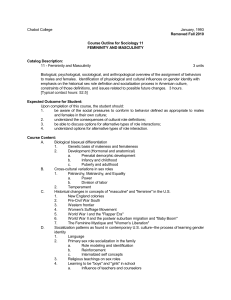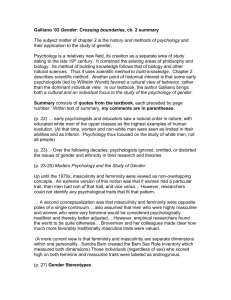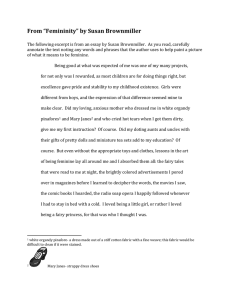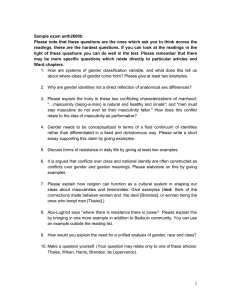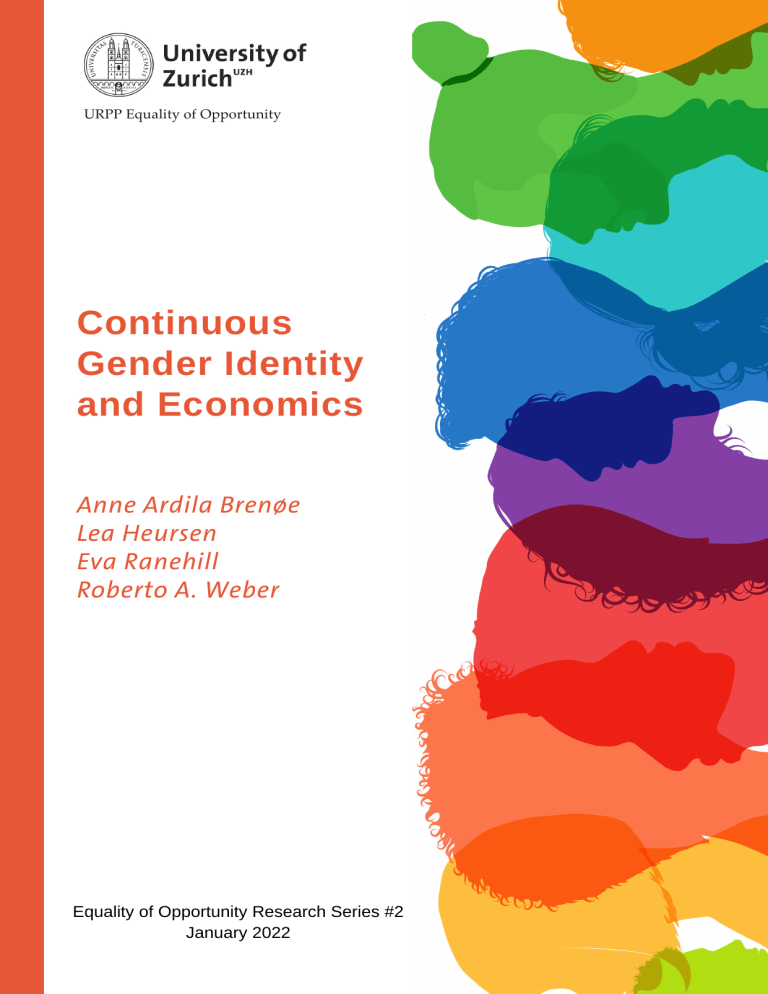
URPP Equality of Opportunity Continuous Gender Identity and Economics Anne Ardila Brenøe Lea Heursen Eva Ranehill Roberto A. Weber Equality of Opportunity Research Series #2 January 2022 URPP Equality of Opportunity URPP Equality of Opportunity Discussion Paper Series No.2, January 2022 Continuous Gender Identity and Economics Anne Ardila Brenøe University of Zurich anne.brenoe@econ.uzh.ch Lea Heursen Humboldt University Berlin lea.heursen@hu-berlin.de Eva Ranehill University of Gothenburg eva.ranehill@economics.gu.se Roberto A. Weber University of Zurich roberto.weber@econ.uzh.ch The University Research Priority Program “Equality of Opportunity” studies economic and social changes that lead to inequality in society, the consequences of such inequalities, and public policies that foster greater equality of opportunity. We combine the expertise of researchers based at the University of Zurich’s Faculty of Arts and Social Sciences, the Faculty of Business, Economics and Informatics, and the Faculty of Law. Any opinions expressed in this paper are those of the author(s) and not those of the URPP. Research published in this series may include views on policy, but URPP takes no institutional policy positions. URPP Discussion Papers often represent preliminary work and are circulated to encourage discussion. Citation of such a paper should account for its provisional character. URPP Equality of Opportunity, University of Zurich, Schoenberggasse 1, 8001 Zurich, Switzerland info@equality.uzh.ch, www.urpp-equality.uzh.ch Continuous Gender Identity and Economics By ANNE ARDILA BRENØE, LEA HEURSEN, EVA RANEHILL, AND ROBERTO A. WEBER* of identity, and agreement with or divergence * Brenøe: University of Zurich, Schönberggasse 1, 8001 Zurich, Switzerland (anne.brenoe@econ.uzh.ch). University of Berlin, Heursen: Humboldt (lea.heursen@hu-berlin.de)., from societal norms (e.g., Knaak, 2004; Germany Westbrook & Saperstein, 2015). In this (lea.heursen@hu-berlin.de). Ranehill: University of Gothenburg, Vasagatan 1, 41124 (eva.ranehill@economics.gu.se). Blümlisalpstrasse 10, Gothenburg, Weber: Sweden University of 8006 Zurich, literature, gender is often measured through Zurich, subjective Switzerland (roberto.weber@econ.uzh.ch). This work was supported by the University Research Priority Program “URPP Equality assessments of masculinity, femininity, or possibly both (Bem, 1974; of Magliozzi et al., 2016). Opportunity” of the University of Zurich. Whether Over the past few decades, economists have this richer, non-binary and become increasingly interested in the topic of subjective conceptualization of gender is useful gender. Part of this work documents gender for economics is not immediately obvious. On gaps in basic economic preferences, such as one hand, using a subjectively constructed self- risk tolerance (e.g., Niederle 2016), and how assessment these gaps correlate with important outcomes, complicates analysis due to potential noise and such as educational choice (e.g., Buser, bias. On the other hand, substantial variation Niederle and Oosterbeek 2014). within biologically “male” and “female” as an explanatory variable To date, economic research exploring gender samples in both behavioral tendencies like risk preference gaps has, with a few prominent preferences (Nelson, 2015) and in economic exceptions (e.g., Akerlof and Kranton 2000), outcomes (Goldin, 2016) suggests that a richer focused on differences by biological sex—a classification binary classification as either a “man” or dimensions of individual heterogeneity useful “woman”—rather than gender identity. This for positive economics and for the design of approach more carefully targeted policy interventions. is sensible, as this binary may important classification is ubiquitous in datasets. At the Moreover, same time, substantial research in gender individuals as non-binary and the growing studies argues for a conceptualization of inclusion of richer measures of gender identity gender as a manifestation of individual traits in administrative datasets creates opportunities and behaviors, social and personal perceptions for using these measures in economic research. 1 increasing capture identification by Our research studies the value of A. Methods incorporating richer, subjective, self-assessed The survey sample consisted of 54 women notions of gender identity into economics. To and 46 men recruited from the University be useful for economists, it is necessary, first, Registration Center for Study Participants at to have simple measures that can be widely the University of Zurich. employed in administrative datasets and, completing the online survey received a second, to document that such measures add participation fee of CHF 10. The survey value to understanding economic questions included five measures for non-binary gender, beyond the binary measure of (mostly) presented in fixed order as follows: biological sex. 1 Participants BSRI: In the 60-item Bem (1974) Sex Role In a first step, we conducted a survey to Inventory, respondents rate themselves, for validate a concise measure of continuous each item, on a 7-point Likert scale ranging gender identity. We then provide preliminary from “never or almost never true” to “always evidence on the extent to which this measure or almost always true.” Each item of the BSRI adds explanatory power beyond that of a binary is a characteristic, coded as either feminine indicator for biological sex in understanding (“love children”), masculine (“defend my own the propensity to exhibit important economic beliefs”) or neutral (“conscientious”). Hence, traits. This complements the richer study of this this scale measures masculinity and femininity second question in Brenøe, et al. (2021). as independent dimensions. A drawback of the I. Validating a Single-Item Measure of Continuous Gender Identity We collected answers to various scales measuring gender identity used in gender research, along with a novel single-item question. We then investigate the degree to which variation in the former can be accounted for by the latter. 1 We exclude one male participant who indicated having responded unreliably. BSRI is that the masculinity-femininity classifications are derived from somewhat dated gender stereotypes and may therefore measure the extent to which one conforms to these stereotypes and expectations rather than one’s own sense of gender. Two-Dimensional Scale: The two- dimensional scale by Magliozzi et al. (2016) measures both first-order (“how do you see yourself?”) and third-order (“how do most people see you?”) masculinity and femininity rate themselves from “very masculine” to “very on separate dimensions. For each dimension, feminine” on a 7-point scale. The six individual participants indicate their response on 7-point questions address gender-role adoption (“I Likert scales, ranging from “not at all” to consider myself as...”), preference (“Ideally, I “very” masculine or feminine, respectively. would like to be...”), and identity Single Item Continuous Gender Identity (“Traditionally, my interests/attitudes and (CGI): Our own scale measures first-order beliefs/behavior/outer appearance would be perceptions of gender identity (“Where would considered as...”). you put yourself on this scale?”) by eliciting We also asked a set of demographic self-placement on a 7-point scale, ranging from questions. All participants reported a current “very masculine” to “very feminine.” The main gender that matched their (reported) biological difference with sex at birth; henceforth, we use biological sex the Magliozzi scale is to distinguish between men and women. measurement of masculinity and femininity in a single dimension. Following Magliozzi et al., B. Analysis and Choice of Gender Measure we also elicited a measure of third-order beliefs To compare our measures, we standardize all (“Where would other people put you on this scores. We score the BSRI following the test scale?”). manual and get results similar to Bem (1981, p. OSRI: We searched for a modernized version 71). 37.0% (13.3%) of the women (men) in our of the BSRI, settling on the 20-item open- data classify as feminine, 14.8% (37.9%) as source Open Sex-Role Inventory (2019). masculine and 27.8% (24.4%) as androgynous. Masculine items (“I like guns”) or feminine In the two-dimensional scale by Magliozzi et items (“I have kept a personal journal”) are al. (2016), and in our unidimensional scale, we rated on a 7-point Likert scale ranging from find high correlations of almost 0.9 between “strongly disagree” to “strongly agree.” While responses to first- and third-order questions. not a published instrument, De Roover and We also use principal component analysis to Vermunt (2019) compared masculinity and extract a measure of the underlying latent femininity across sexual orientations using a continuous gender identity from the seven large dataset. TMF: In Traditional the unidimensional Masculinity Femininity existing scales (online Appendix Table A1). 6-item Table 1 presents the correlations between scale the continuous gender measures, while Figure developed by Kachel et al. (2016) respondents 1 illustrates these relationships. The corre3 TABLE 1 – CORRELATION MATRIX OF FEMININITY-MASCULINITY SCALES FROM ONLINE SURVEY BSRI Fem BSRI Masc Mag Fem Mag Masc OSRI Fem OSRI Masc TMF First Component Single Item BSRI Fem CGI 0.292 (0.003) -0.199 -0.220 (0.049) (0.029) 0.305 0.903 (0.002) (0.000) -0.223 -0.913 (0.027) (0.000) 0.390 0.527 (0.000) (0.000) -0.207 -0.561 (0.040) (0.000) 0.329 0.914 (0.001) (0.000) 0.457 0.918 (0.000) (0.000) BSRI Masc Mag Fem Mag Masc OSRI Fem OSRI Masc TMF -0.165 (0.104) 0.270 (0.007) -0.016 (0.878) 0.236 (0.019) -0.279 (0.005) -0.333 (0.001) -0.813 (0.000) 0.600 (0.000) -0.531 (0.000) 0.882 (0.000) 0.915 (0.000) -0.467 (0.000) 0.533 (0.000) -0.845 (0.000) -0.879 (0.000) -0.234 (0.020) 0.568 (0.000) 0.671 (0.000) -0.623 (0.000) -0.683 (0.000) 0.948 (0.000) Notes: p-values are reported in parentheses. Fem (Masc) refers to the femininity (masculinity) scores of the two-dimensional BSRI, OSRI and Magliozzi (Mag) scales. Single Item CGI is the score from our single question's unidimensional scale, ranging from "very masculine" to "very feminine"; TMF is an alternative unidimensional measure. First Component is the first component from a principal component analysis of the seven continuous scales (excluding our single item measure). Source: Brenøe, et al., 2021. lations all have the appropriate sign, indicating women (men) consider themselves equally reliability of the different measures of gender feminine (masculine), but instead perceive identity. The coefficients are smaller in their gender identity heterogeneously. magnitude for both dimensions of the BSRI We conclude that (i) our single-item measure than for other scales, but the correlations are captures a substantial share of the variation in nevertheless The gender identity measured by other scales and correlations for the separate dimensions of the (ii) there is substantial variation in continuous two-dimensional scales are negative, indicating gender identity. We next provide preliminary that substantial variation on these scales might evidence on the relationship between gender be unidimensional in nature. Our scale also identity and economic preferences. statistically significant. correlates highly with the first component extracted from principal component analysis. Our unidimensional scale demonstrates both variation and overlap in reported gender identity between men and women (Figure A1 in the online Appendix). Participants used the full 7-point scale to self-identify, with men (women) using the five most masculine (feminine) categorical responses. Thus, not all II. Preliminary Evidence on Continuous Gender and Economic Decision Making We implemented a computerized experiment with 120 participants. In this (pre-registered; doi.org/10.17605/OSF.IO/PHYT6) pilot experiment, we elicited our measure of continuous gender identity and biological sex & Vesterlund, 2007). We followed the experimental procedures used in earlier research as closely as possible. To control for possible measurement error in non-binary gender identity, we followed the procedure proposed by Gillen et al. (2019) and collected a second set of responses to the gender identity scale in an online follow-up survey three weeks after the laboratory experiment. Table 2 presents results from regression analysis of the incentivized behavioral measures on biological sex and continuous gender identity. Panel A presents OLS regressions of each preference measure on biological sex, finding that women are less risk seeking, competitive, prioritize efficiency overconfident, less than and equality compared to men, consistent with previous research. Panel B repeats this exercise using self-reported gender identity instead of biological sex, finding similar results—gender FIGURE 1. BINNED SCATTER PLOTS DEPICTING THE RELATIONSHIP BETWEEN THE DIFFERENT CG SCALES AND OUR SINGLE ITEM identity predicts all four economic preference Note: Fem (Masc) refers to the femininity (masculinity) scores of each of the BSRI, OSRI, and Mag (Magliozzi) scales. Single Item represents our single question, ranging from "very masculine" to "very feminine"; TMF has a similar scale. First Component is the first component from a principal component analysis of the seven continuous gender scales (excluding our single item measure). measures. However, as shown in Panel C, including both biological sex and gender along with four measures of economic identity as explanatory variables, the latter preferences for which previous research has displays substantial explanatory power beyond documented robust gender gaps: risk taking, that of biological sex only for risk attitudes— competitiveness, preferences for equality over in this case, the continuous measure of gender efficiency, and overconfidence (Fisman, Kariv, identity is & Markovits, 2007; Gillen, Snowberg, & biological sex is not. While these are only Yariv, 2015; Gneezy & Potters, 1997; Niederle 5 statistically significant while TABLE 2 – REGRESSION OF INCENTIVIZED BEHAVIORAL MEASURES ON BIOLOGICAL SEX AND CONTINUOUS GENDER IDENTITY Risk Competitiveness Overconfidence Equality vs. Efficiency (𝜌𝜌) Panel A. Biological sex Biological Female -0.674 (0.179) -0.453 (0.084) -0.514 (0.176) -1.280 (0.543) -0.435 (0.092) Panel C. Gender identity and biological sex Biological Female -0.125 (0.314) Single Item CGI (ORIV) -0.380 (0.175) Observations 120 Mean of Dependent Variable -0.000 -0.208 (0.053) -0.246 (0.110) -0.558 (0.332) -0.418 (0.155) -0.024 (0.094) 120 0.533 -0.437 (0.262) -0.053 (0.169) 120 0.000 -1.304 (0.858) 0.017 (0.533) 114 5.325 Panel B. Gender identity Single Item CGI (ORIV) Notes: Robust standard errors in parentheses. The estimates in each column and panel come from a separate regression. Panel A regresses the four incentivized behavioral measures [risk (standardized, mean zero, standard deviation one), competitiveness (binary), overconfidence (standardized) and ρ (deciles, sample with few GARP violations in allocation choices following Fisman et al. 2007)] on biological sex and uses HC3 standard errors. Panels B and C instrument our standardized single item CGI question (11-point scale) elicited in the lab with a similar question in the follow up survey (12-point scale). All regressions control for session fixed effects and a constant. Source: Brenøe, et al., 2021. preliminary findings in the early stage of a and a set of important economic preferences larger data collection, they suggest added and beliefs. explanatory power from incorporating self- REFERENCES reported measures of continuous gender identity, mainly in the domain of risk. Akerlof, George A. and Rachel E. Kranton. 2000. III. Conclusion “Economics and Identity.” The Quarterly Journal of Economics 115(3): While much work remains to determine 715–753. whether continuous measures of self-reported Brenøe, Anne. A., Lea Heursen, Eva gender identity can be useful for understanding Ranehill and Roberto Weber. 2021. economic “Gender Identity and Economic Decision behavior and valuable for policymaking, this paper reports two important steps in this direction. First, we identify a short Making.” Unpublished. Bem, Sandra L. 1974. “The Measurement of single-item question that correlates with richer Psychological Androgyny.” measures used in gender research, thereby Consulting and Clinical Psychology 42(2): providing a simple measurement instrument. 155–62. Journal of Second, we provide preliminary evidence on Bem, Sandra L. 1981. Bem Sex-Role the usefulness of this measure for better Inventory: Professional Manual. Palo Alto, accounting for the relationship between gender CA: Consulting Psychologists Press. Claudia Buser, Thomas, Muriel Niederle, and Hessel Oosterbeek. 2014. Niedlich. 2016. “Traditional “Gender, Masculinity and Femininity: Validation of a Competitiveness, and Career Choices.” The New Scale Assessing Gender Roles.” Quarterly Journal of Economics, 129(3): Frontiers in Psychology 7: 956. Knaak, 1409–1447. De Roover, Kim, and Jeroen K. Vermunt. 2019. “On the Exploratory Road Modeling: “On the for Research Design.” Sociological Inquiry to 74(3): 302–17. Magliozzi, Devon, Aliya Saperstein, and A New Multigroup Rotation Approach.” Equation 2004. Reconceptualizing of Gender: Implications Unraveling Factor Loading Non-Invariance: Structural Stephanie. Laurel Westbrook. 2016. “Scaling Up: A Multidisciplinary Journal 26(6): 905–23. Representing Gender Diversity in Survey Fisman, Raymond, Shachar Kariv, and Research.” Socius: Sociological Research Daniel Markovits. Preferences for 2007. for a Dynamic World 2. “Individual Giving.” Nelson, Julie A. 2015. “Are Women Really American More Risk-Averse than Men? A Re-Analysis Economic Review 97(5): 1858–76. Gillen, Ben, Erik Snowberg, and Leeat Yariv. of the Literature Using Expanded Methods.” with Journal of Economic Surveys 29(3): 566–85. with Niederle, Muriel, “Gender” Handbook of Applications to the Caltech Cohort Study.” Experimental Economics, second edition, Journal of Political Economy 127(4): 1826- Eds. John Kagel and Alvin E. Roth, 1863. Princeton University Press, 2016, 481-553. 2019. Measurement “Experimenting Error: Techniques Gneezy, Uri, and Jan Potters. 1997. “An Niederle, Muriel, and Lise Vesterlund. 2007. Experiment on Risk Taking and Evaluation “Do Women Shy Away from Competition? Periods.” Do Men Compete Too Much?” The The Quarterly Journal of Quarterly Journal of Economics 122(3): Economics 112(2): 631–45. Goldin, Claudia, Lawrence F. Katz. 2016. 1067–1101. “A Most Egalitarian Profession: Pharmacy Westbrook, Laurel, and Aliya Saperstein. and the Evolution of a Family Friendly 2015. “New Categories Are Not Enough: Occupation.” Journal of Labor Economics Rethinking the Measurement of Sex and 34(3): 705-745. Gender in Social Surveys.” Gender & Kachel, Sven, Melanie C. Steffens, and Society 29(4): 534–60. 7 Continuous Gender and Economics By ANNE ARDILA BRENØE, LEA HEURSEN, EVA RANEHILL, AND ROBERTO WEBER ONLINE APPENDIX FIGURE A1. DISTRIBUTIONS OF MAGLIOZZI FEMININITY, MASCULINITY AND OUR UNIDIMENSIONAL SCALE b) Magliozzi Femininity 50 Percent 40 30 20 10 0 -2 -1 Male 2 1 0 Femininity scale Female c) Magliozzi Masculinity 50 Percent 40 30 20 10 0 -2 -1 0 Masculinity scale Male 1 2 Female Note: Scores are from the first-order gender identity questions and are standardized to have a mean of zero and a standard deviation of one. For our single item CGI question in Panel (a), the unidimensional scale ranges from “very masculine” to “very feminine” on a 7-point scale. For the Magliozzi scales in Panels (b) and (c), the scales range from “not at all” to “very” masculine and feminine, respectively. TABLE A1 – PRINCIPAL COMPONENT ANALYSIS OF THE SEVEN CONTINUOUS GENDER SCALES Panel A. Component loadings Comp1 BSRI Fem 0.236 BSRI Masc -0.172 Mag Fem 0.473 Mag Masc -0.454 OSRI Fem 0.347 OSRI Masc -0.353 TMF 0.490 Panel B. Eigenvalues and variance explained Eigenvalue Component 1 3.745 Component 2 1.037 Component 3 0.953 Component 4 0.607 Component 5 0.388 Component 6 0.169 Component 7 0.100 Comp2 0.121 0.797 0.134 0.055 0.501 0.279 -0.010 Comp3 0.824 -0.341 -0.159 0.234 0.225 0.239 -0.133 Unexplained 0.129 0.119 0.120 0.171 0.242 0.398 0.085 Difference 2.708 0.084 0.346 0.219 0.219 0.068 . Proportion 0.535 0.148 0.136 0.087 0.055 0.024 0.014 Cumulative 0.535 0.683 0.819 0.906 0.962 0.986 1.000 Note: This table shows the results from a principal component analysis of the seven continuous gender scales (excluding our single item measure). Panel A presents the component loadings for the first three components; the final column, ‘unexplained’ refers to the proportion of the variance which cannot be explained when only these first three components are considered. Taken together, the seven components explain 100 percent of the variance. Panel B lists the eigenvalues corresponding to each component (column 1), and the difference between these eigenvalues. The final two columns report the proportion and cumulative proportion of the variance which can be explained by the relevant components.

